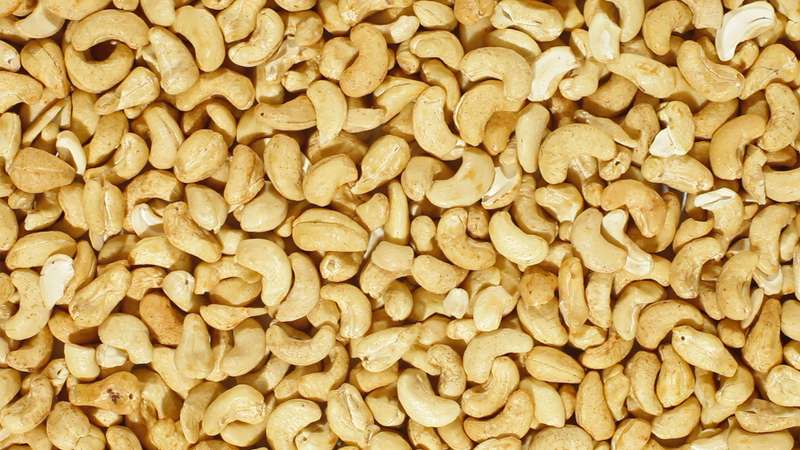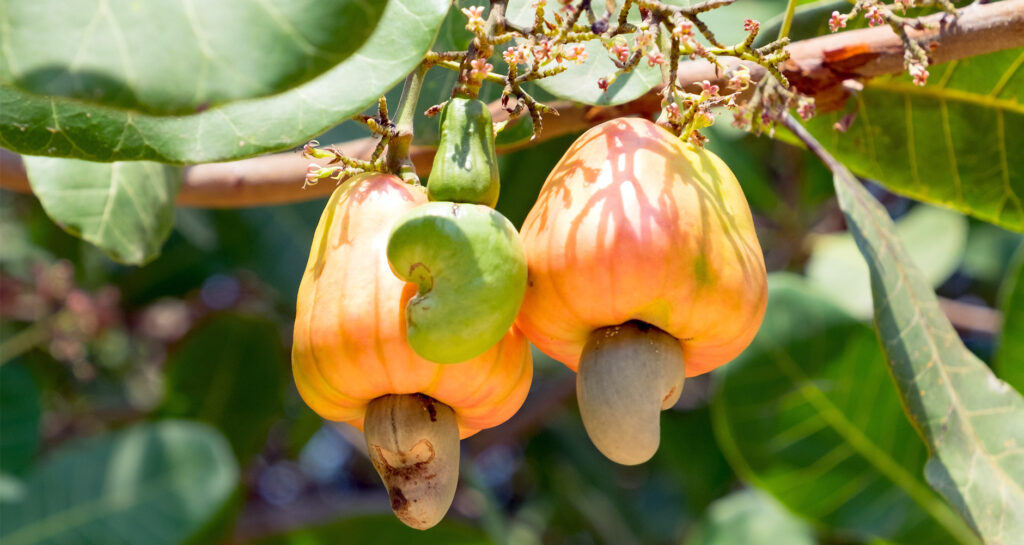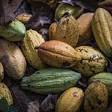HISTORY OF CASHEW

The cashew nut—or the actual fruit of the cashew tree, Anacardium occidentale—now figures prominently in a canonical modern list of “superfoods.” But with the highest magnesium content per serving of any tree nut (aside from Brazil nuts and almonds), rich Vitamin E cancer-fighting phytochemical properties, and a tasty flavor to boot, cashew nuts
deserve their growing reputation.
Cashew nuts are the fruit of the cashew tree, which is native to Brazil, but was brought to Africa and India by the Portuguese in the 16th century. Cashew trees can grow up to 10 metres tall. Cashew nuts are kidney-shaped and are attached to the bottom of ‘false fruit’ which grows from the flower stalks. These are called ‘cashew apples’, even though they look more like pears. Each ‘apple’ produces just one nut. Cashew nuts are 3 cm long
and composed of a kernel covered by a thin skin and two shells. The inner shell is very hard and difficult to crack. Between the two shells is a toxic and highly caustic oily substance. If you try to remove the kernel with your fingers, this substance burns your skin and causes
blisters.
The cashew has long been a staple of Asian cuisines and is likely to be found chopped up in your favorite curry or stir-fry. In the West, it’s a common ingredient in pastries like cookies and cakes. It’s also packaged on their own as stand-alone snacks. Cashews are also behind modern vegan and vegetarian innovations like healthy plant-based milk and plant-based
cheese.
What the origins of this odd kidney-shaped tree nut, what parts of the tree have historically been in use for human consumption, and how do the by-products shape the market today? Here’s a brief history of one of the world’s most widely-consumed nuts for you to snack on.
A TREE OF THE TROPICS

Though it’s not the first country we associate cashew nuts with, the cashew tree is actually native to northeastern Brazil. This evergreen shrub flourished in the tropics in a similar way to its cousin varieties of mango, pistachio, and poison ivy. At some point, cashew oil was believed to be a natural remedy for the disease of leprosy.
Portuguese sailors landed in Brazil in the 16th century, and thus brought the cashew plants aboard their ships to India and East Africa. The hot weather, humid climate, and rich soil conditions allowed the cashew trees to thrive in these regions. When commercial tree growing peaked in the 21st century, cashew trees also flourished in countries like Nigeria,
the Ivory Coast, Indonesia, and Vietnam. Suffice to say, cashew trees love the sun and live off of the tropical weather.
RESILIENCE OF THE CASHEW TREE
What are the other factors that have allowed for the cashew tree to endure throughout history? For one, the trees can begin bearing fruit as early as two to three years after they are planted. For another, they are remarkably resilient trees—they are drought-resistant and can still grow even in marginal soil.
But perhaps the most outstanding quality of the cashew tree is its adaptability. Of course, this manifests in its primary byproduct of the cashew nut, which is a kidney-shaped drupe (or stone fruit) plucked off the bottom of a soft and fleshy cashew apple. The nuts are roasted and dried so as to render their poisonous outer shells easy to remove. Around the
1980s, scientists have also begun studying the anacardic acid in these shells for medicinal purposes, especially with regard to their antibiotic properties.
Still, the cashew tree yields more than the nuts themselves. The cashew apple is said to be juicy, sweet, and citrusy in flavor, but it can only be enjoyed by cashew growers themselves as it perishes within 24 hours of being picked. Moreover, cashew tree wood is renowned by woodworkers to be stable, light, and easy to work with.
USES
Only shelled cashew nut kernels are sold. As they turn rancid quickly, the kernels need to be stored preferably in vacuum-packed bags in the refrigerator. They are used whole, chopped, roasted, salted or unsalted. They are eaten whole, mainly as a snack. In the countries where they are produced, they are also used as cooking ingredients.
‘Cashew apples’ are eaten raw or cooked and made into juice and syrup. They can also ferment and be made into wine. In Brazil, the cashew tree’s native country, the apples are considered a delicacy and are preferred over walnuts.
Adipostatin A, or cardol, is collected and used to make varnish, resin, waterproofing products, ink and insecticides.
Source: Lukeosaurusandme, and Alimentarium








